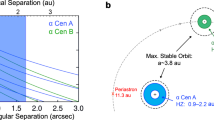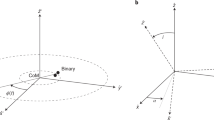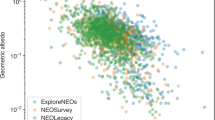Abstract
THE construction of several large ground-based telescopes1,2 and the anticipated launches of new space-based ones3-5, have prompted renewed interest in the means by which extra-solar planets might be discovered1,6,7-11. The direct detection of light from such a planet would be the most compelling means of discovery, and it may soon be technically feasible1,6. Jupiter has traditionally been used as a benchmark for observability, but extra-solar giant planets could have a wide range of masses and ages12, and could be significantly brighter than Jupiter. Here we present calculations estimating the optical and infrared fluxes of extra-solar giant planets with a range of ages, and demonstrate the conditions under which they will be observable with several new telescopes. Giant planets with masses greater than that of Jupiter, and younger than about 1 billion years, are the best targets, and they should be visible using the generation of telescopes now under construction.
This is a preview of subscription content, access via your institution
Access options
Subscribe to this journal
Receive 51 print issues and online access
$199.00 per year
only $3.90 per issue
Buy this article
- Purchase on Springer Link
- Instant access to full article PDF
Prices may be subject to local taxes which are calculated during checkout
Similar content being viewed by others
References
Angel, R. Nature 368, 203–207 (1994).
Mountain, M., Kurz, R. & Oschmann, J. Proc. SPIE 2199, 41–55 (1994).
Thompson, R. Space Sci. Rev. 61, 69–93 (1992).
Erickson, E. F. & Werner, M. W. Space Sci. Rev. 61, 95–98 (1992).
Benvenuti, P. et al. in ESA's Report to the 30th COSPAR Meeting, ESA SP-1169 (ed. Burke, W. R.) 78–81 (ISO, Paris, 1994).
Burke, B. F. et al. TOPS: Toward Other Planetary Systems (NASA Solar System Exploration Division, Washington DC, 1992).
Gatewood, G. D. Astr. J. 94, 213–224 (1987).
Reasenberg, R. D. et al. Astr. J. 96, 1731–1745 (1988).
Walker, G. A. H. et al. Icarus (in the press).
Mao, S. & Paczynski, B. Astrophys. J. 374, L37–L40 (1991).
Borucki, W. J. & Summers, A. L. Icarus 58, 121–134 (1984).
Podolak, M., Hubbard, W. B. & Pollack, J. B. in Protostars and Planets III (eds Levy, E. & Lunine, J. I.) 1109 (Univ. Arizona Press, Tucson, 1993).
Burrows, A., Hubbard, W. B. & Lunine, J. I. Astrophys. J. 345, 939–958 (1989).
Burrows, A., Hubbard, W. B., Saumon, D. & Lunine, J. I. Astrophys. J. 406, 158–171 (1993).
Graboske, H. C., Pollack, J. B., Grossman, A. S. & Olness, R. J. Astrophys. J. 199, 265–281 (1975).
Hubbard, W. B. Icarus 30, 305–310 (1977).
Saumon, D. & Chabrier, G. Phys. Rev. A44, 5122–5141 (1991).
Saumon, D. & Chabrier, G. Phys. Rev. A46, 2084–2100 (1992).
Pollack, J. B. A. Rev. Astr. Astrophys. 22, 389–424 (1984).
Bodenheimer, P. & Pollack, J. B. Icarus 67, 391–408 (1986).
Boss, A. P. Science 267, 360–362 (1995).
Conrath, R. A., Hanel, R. A. & Samuelson, R. E. in Origin and Evolution of Planetary and Satellite Atmospheres (eds Atreya, S. K., Pollack, J. B. & Matthews, M. S.) 513–538 (Univ. Arizona Press, Tucson, 1989).
Saumon, D., Hubbard, W. H., Chabrier, G. & Lunine, J. I. Astrophys. J. 391, 827–831 (1992).
Guillot, T., Chabrier, G., Gautier, D. & Morel, P. Astrophys. J. (in the press).
Black, D. C. Icarus 43, 293–301 (1980).
Pearl, J. C. & Conrath, R. A. J. geophys. Res. Suppl. 96, 18921–18930 (1991).
Erickson, E. F. Space Sci. Rev. 61, 61–68 (1992).
Zuckermann, B., Forveille, T. & Kastner, J. H. Nature 373, 494–496 (1995).
Lin, D. N. C. & Papaloizou, J. Mon. Not. R. astr. Soc. 186, 799–812 (1979).
Wetherill, G. W. Lunar Planet. Sci. Conf. XXIV, 1511–1512 (1993).
Dreiling, L. A. & Bell, R. A. Astrophys. J. 241, 736–758 (1980).
Author information
Authors and Affiliations
Rights and permissions
About this article
Cite this article
Burrows, A., Saumon, D., Guillot, T. et al. Prospects for detection of extra-solar giant planets by next-generation telescopes. Nature 375, 299–301 (1995). https://doi.org/10.1038/375299a0
Received:
Accepted:
Issue Date:
DOI: https://doi.org/10.1038/375299a0
Comments
By submitting a comment you agree to abide by our Terms and Community Guidelines. If you find something abusive or that does not comply with our terms or guidelines please flag it as inappropriate.



